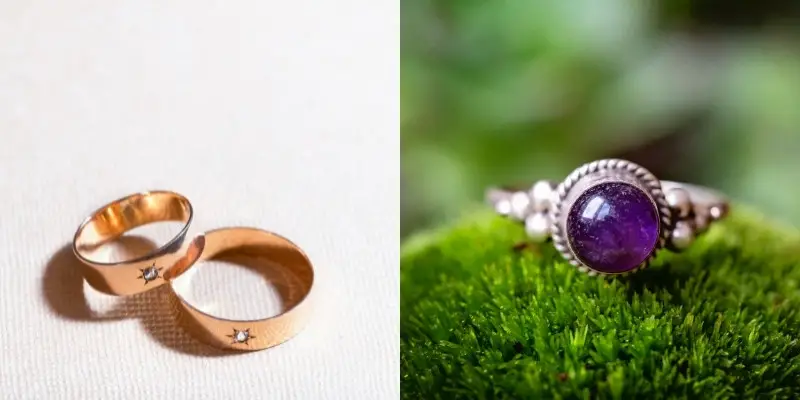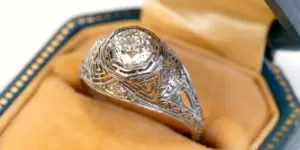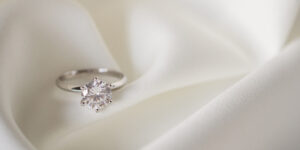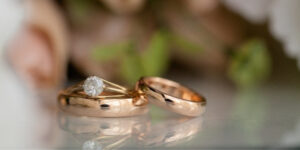An engagement ring is usually meant to be worn every single day for the rest of your life. But what do you do when you have a very active lifestyle, or have a job that involves your hands very much and just can’t wear the typical engagement ring ? You look for something that will fit in with your active lifestyle, of course !
There are at least two ring settings perfect for such situations, and a maybe-yes-maybe-not setting that we’ll discuss as well. These settings also work very well for people who are not active but simply don’t want to have their engagement ring get in the way of everyday life. So let’s take a look.
Best ring setting for active lifestyle
The best ring settings for an active lifestyle are the flush setting, followed by the bezel setting. Both settings offer high security, as they hold onto the diamond from the girdle and reach onto the crown a bit, so that diamond will stay put. The flush setting is a lower profile setting than bezel, but this is also influenced by the carat size of the diamond and how many stones there are. Here’s each setting discussed in more detail.
Flush setting – the diamonds are nestled directly into the ring shank itself, into the metal, covering the girdle. If you were to rub your finger over the diamond you wouldn’t easily tell where the metal stops and the diamond starts. The diamond’s table is perfectly aligned with the ring shank, for an almost seamless feel, and the highest security possible.
The downside is that you cannot set very large diamonds, and they do not receive as much light as other settings.

Bezel setting – a band of metal goes all around the diamond, hugging the girdle and a bit of the crown. It usually reaches all the way down to the ring shank, forming a sort of tube. This setting works best in a low cathedral setting, that is a ring with shoulders leading from the bezel to the shank.
The downside is it can look bulky and the diamond won’t receive very much light.
Read also: Gem Settings: How And Why Your Diamond Is Set That Way
Channel setting – the maybe yes, maybe not setting for active lifestyles. This setting style has the diamonds in a row, nestled into each other, with a band of metal going on either side, forming a channel in which the diamonds are ‘trapped’. This way all the sides of a diamond are secured, with metal and with other diamonds.
You might be wondering why a channel setting might be fine but a pave isn’t mentioned yet. This is because the channel setting has the metal set above the diamond table, so when you hit the ring against a flat surface, the table of the diamond is virtually untouched. Whereas a pave setting has 4 prongs on each diamond and the table and crown of the diamond are more exposed.
Even so, a channel setting won’t be good if you’re going to the gym, or doing some serious gardening. But it will be better than other options, if neither flush or bezel sound good to you.
Read also: Do Emerald Cut Diamonds Sparkle ?
Low profile rings allow you to do most things unhidered
The overarching theme of the flush and bezel setting is that they are a low profile setting. When you take channel setting into account, they really are low rings that won’t easily snag onto clothes, and will allow you to squeeze your hand somewhere if you have to.
An active lifestyle can look very, very different for many people. It can mean someone who works out a lot and regularly visits the gym, lifts weights, does cardio. It could mean someone who is a marathon runner. It could mean a medic who is always on their feet, possibly a surgeon who cannot afford to lose a diamond in a patient. It could be a dog groomer, busy washing, clipping nails, trimming fur, and managing temperamental dogs. It could be someone who works construction, or a gardener, or it could just be a very busy stay at home parent.
Whatever the particular case, a low profile ring will always be a good option if there is a lot of work to be done. This kind of ring won’t get in the way too much.
Consider a gem-free ring for very difficult activities
If you really don’t want to damage your engagement ring, we recommend you get a simpler, gem-free band to wear as your engagement ring when you know you will be doing something very strenuous. These bands don’t have to be plain, they could be engraved on the outside, they could be patterned, they could have something very personal for you.
At least a gem-free band is cheaper to replace if lost or damaged, and you don’t have to worry about a diamond falling out.
Should you wear your engagement ring when you workout ?
No, do not wear your engagement ring to the gym or to a workout. Any rings or jewelry you have should be taken off before you enter the gym, regardless of how mild or intense your workout is. Any workout is bound to make you sweat, and if you’re also lifting weights your rings will be damaged in time (scratches). In a worst case scenario your ring could snag on the equipment and lead to an accident, and no one want to be a part of that.
As a personal example, we are married and we both take off our wedding bands and my engagement ring when we go to the gym. Our hands go through at lot, lifting weights, swelling from increased blood flow, getting sweaty, moving equipment. There is no reason to take the rings with us, so we just slip them off before we leave.
What is the most durable engagement ring metal ?
The most durable engagement ring metal is palladium, closely followed by platinum. Palladium is very difficult to find so you should stick to platinum instead. Gold is also an option, but choose 14k over 18k because it is tougher due to containing less soft gold.
Platinum and 14k gold engagement rings are common, so you should have no trouble at all getting a ring or a ring setting you like. Palladium is stronger than both but much harder to find and harder to work with (as a jeweler) so expect a much higher price tag (about double than platinum).
No matter which you choose your engagement ring will last you a literal lifetime, as long as you take your ring for regular maintenance. if your engagement ring has a prong setting or many stones (like a halo or a cluster) you really need to have it checked once a year for any loose stones.
Ring settings to avoid if you have an active lifestyle
Want a rundown of the ring settings that will always get in the way if you’re a very busy person and why they do that ? We’ve got you covered. After all most of these rings settings are truly beautiful and also very popular, but most people don’t consider their lifestyle before settling on a ring. Don’t be that person, be smart and know what to avoid if you’re not sedentary.
Now, these following styles are all fine if you always take your ring off before showering, doing kitchenwork, cleaning, going swimming, sleeping, and so on. But, if you prefer to live in your engagement ring (as I do), then these styles should be avoided.
Anything with many stones (eternity, pave, halo, cluster)
Many stones on a ring mean a whole lot of sparkle, and indeed most people are attracted to everything shiny, including us. This means your engagement ring will catch the eye, be extra beautiful, and might even make your friends jealous.
But extra stones mean extra worry, and more stones to knock out of their setting if you’re a very, very busy person. Here’s what we mean:
- halo rings can get in the way (bulky) and may be too high profile
- cluster rings can take up a loot of space on the finger, are often pave rings
- eternity and pave rings, with stones on the rink shank, expose the diamonds to direct hits
Anything that is high-profile (cathedral, trellis)
A high-profile ring brings the diamond closer to your eyes and gives the ring a bit of an elegant feel to it. However these high profile rings can truly get in the way and snag, especially if they’re prong-set. I should know, my own ring is a cathedral setting with 4 prongs and I often take it off before cleaning, working out, and when cooking something more saucy.
Anything tension-set, you risk knocking the gem out of the setting
A tension setting is not something you see every day, but it’s definitely a style work by some people so it has to be on this list. The entire point of a tension setting is the reliance on the tension within the metal band holding the diamond in place. There are grooves within the shank that keep the diamond in place, but bend that metal just a bit and the diamond will start to spin in place and later fall out. Definitely not something you want to risk.
So in short, the only safe settings are flush and bezel, and maybe channel setting if you’re not too active but also not sedentary. The whole point is to not hurt yourself or lose the gems, so no matter what kind of ring you have it might just be a good idea to take it off before doing any serious activity.

I’m the main author for jewelrymaterialguide.com. I started this site after we did tons of research before our wedding and noticed that there is information about rings, jewelry, and so on that is really hard to find on the internet.






